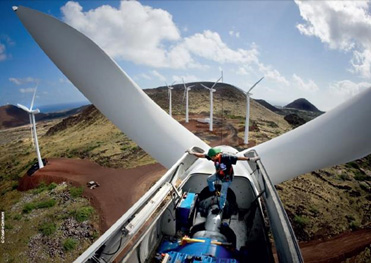Faith, Hope and the Energy Revolution in Japanese
(First published on Huffpost Green on 10 February 2016)
Fighting for a renewables revolution to save the climate has, for the past 30 years, been a question of faith in the ultimate self-interest of humankind, and hope that we would develop the means for our deliverance. The last time I felt this hopeful was in the autumn of 2004 when we raised (many) glasses of vodka to toast the Russian Duma when it passed the legislation for ratification of the Kyoto Protocol, meaning that the treaty would enter into force. Those hopes ultimately proved unfounded, but now, in the wake of the Paris agreement, we have some new numbers from the renewables industry which shows that we have the technology. Now, do we have the will to do it?
Despite cratering fossil fuel prices, investments in renewable energy reached a record US$ 329 billion in 2015. Renewables added more capacity than conventional sources in the US, China (for the 3rd year in a row) and the European Union for the 9th consecutive year. Wind energy was the leading source of new additions.
Powered by an astonishing 30,500 MW of new installations in China, the global wind power industry installed 63,013 MW in 2015, representing annual market growth of 22%. The US market reached 8.6 GW on the back of a strong fourth quarter surge, and Germany led a stronger than expected performance in Europe with a record 6 GW of new installations, including 2.3 GW offshore. Total global capacity reached 432,412 MW at the end of 2015, representing cumulative growth of 17%.

As a result of its extraordinary annual market, China has edged past the European Union in terms of total installed capacity, with 145.1 GW compared to the EU's 141.6 GW. The Chinese government's drive for clean energy, supported by continuous policy improvement, is motivated by the need to reduce dependence on coal which is the main source of the choking smog strangling China's major cities, as well as growing concern over climate change. Elsewhere in Asia, India chalked up a respectable 2,623 MW, pushing past Spain into fourth place in terms of cumulative capacity.
Wind power is leading the charge in the transition away from fossil fuels, blowing away the competition on price, performance and reliability. Wind already dominates most of the major power markets, and we're seeing new markets open up across Africa, Asia and Latin America which will become the market leaders of the next decade. New turbine configurations have dramatically increased the areas where wind power is the competitive option.
The relatively modest increase in investment in 2015 hides the fact that costs for wind and solar power have dropped dramatically in recent years. Much has been written about the dramatic drop in solar power prices, but wind costs have also dropped dramatically, by as much as 2/3 in the last six years in the United States, for example. Wind power is now the cheapest way to generate electricity from a new plant in a growing number of markets including Australia, Brazil, South Africa, Turkey, most of the US, some parts of China, and across much of Africa. A recent deal for an 850 MW development in Morocco came in at an average price of US $.03/kwh (€.028/kwh), prompting a Moroccan government official to point out that 'the electricity is cheaper than that from a new coal plant, even if the coal was free.'
Installations in developing and emerging economies outpaced those in the OECD by nearly 60% last year, continuing and accelerating the trend that has been developing since 2010. This is of course led by China, India and Brazil, but also includes countries such as Uruguay, which already gets more than 25% of its electricity production from wind and is likely to achieve its goal of 100% renewable electricity in the next couple of years.
Solar PV is also taking off in a big way, and although we don't have final numbers, it seems that total installations are likely to be above 50 GW globally for the first time. All major scenarios agree that wind and solar will dominate new installations in the electricity sector henceforth - not only because they emit no CO2, but because they consume no fresh water in their operation, contribute to energy security and economic stability, create new industries and millions of jobs, and reduce the choking smog that is killing millions in the mega-cities of the developing world.
We're winning the 'carbon war' in the power sector. We need to pay much more attention to energy efficiency, as it is the unit of energy that is not consumed which is always the cheapest. We also need to pay much more attention to both the heating and transport sectors - both of which will come to depend much more on electricity in a wind and solar powered future. Viva la revolucion!

